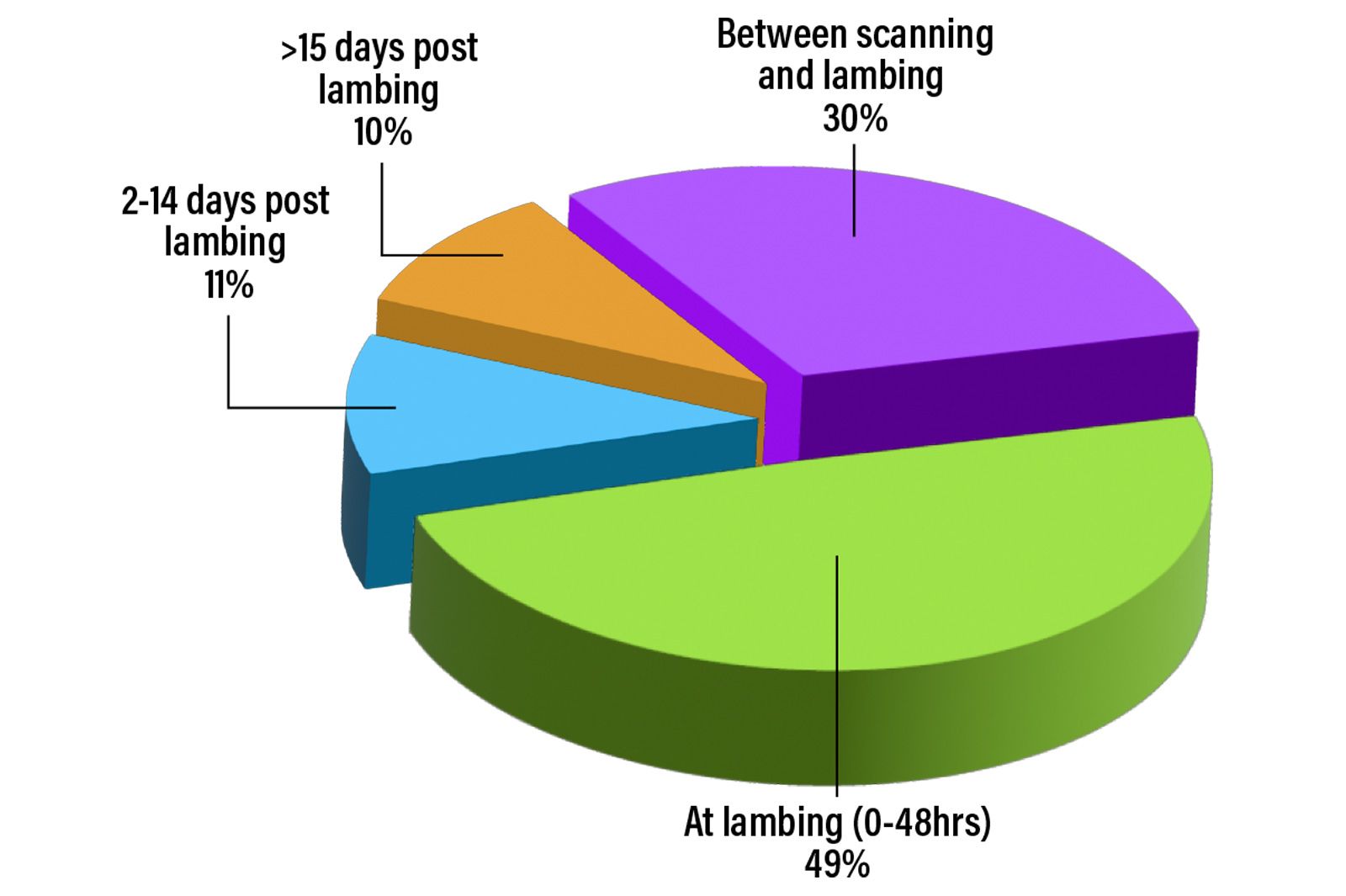Controlling abortion: plan now to protect your flock

The number of lambs weaned per ewe is a critical performance indicator for sheep flocks. The industry aim by 2027 is a target of 1.55 lambs weaned per ewe for mid-season lowland flocks in Ireland. Understanding the factors that influence this metric is essential for farmers striving for success. One significant contributor to lamb loss is the control of abortion, as up to 30 per cent of lamb losses can occur between scanning and lambing (see below image). Infectious causes of abortion are responsible for a large proportion of these losses, with data from regional veterinary laboratories showing that the primary infectious agents are Chlamydophila abortus (causing enzootic abortion of ewes [EAE]) at 22.2 per cent and Toxoplasma gondii (causing toxoplasmosis) at 21.4 per cent of all samples submitted. Other common infectious causes include Campylobacter spp., Listeria spp. and Salmonella spp.

When lamb losses occur (% of total losses)
While abortion storms are easily identified with losses of up to 30 per cent in some cases, any abortions above a level of 2 per cent within a flock should be investigated. Accurate diagnosis is crucial in future control of abortion within a flock. Submitting freshly aborted foetii along with placentae to the local veterinary laboratory will give the best chance of an accurate diagnosis.
Further to this, barren rates exceeding 2 per cent within a flock also warrant investigation. There are several reasons for a high empty rate, with toxoplasmosis being one major cause. Therefore, it is crucial to maintain accurate records and identify barren ewes, as well as those that have previously aborted, to effectively monitor flock performance and direct an investigation.
Remember
Discussing diagnosis and control measures with your vet can help avoid unnecessary pitfalls during this breeding season and subsequent lambing time.
Enzootic abortion of ewes
Enzootic abortion of ewes (EAE) is caused by the bacteria C. abortus. The disease usually enters a naïve flock through the purchase of infected replacements, and to a lesser degree wildlife may be implicated in the spread of infected material between flocks. Transmission is ewe to ewe and occurs through the ingestion or inhalation of the bacteria from infected lambs, placentas, and vaginal secretions following abortion. Aborted ewes will shed the bacteria for up to two weeks post-lambing. Lambs can also be born already infected from ewes carrying the disease. For this reason, it is imperative that any aborted ewes are immediately isolated from the rest of the flock and any aborted materials and contaminated bedding are removed and destroyed. Ewes which are infected in one lambing season will often abort the following season. After infection the bacteria lies dormant (latent infection) until the next pregnancy triggers reactivation leading to the invasion of the placenta, resulting in foetal death, abortion, or the birth of weak live lambs. Abortions tend to occur in the final three weeks prior to lambing time. Although rarely reported, abortions can occur during the same pregnancy if infection occurs more than six weeks pre-lambing. In naïve flocks abortion storms due to EAE may affect up to 30 per cent of the flock. If faced with an outbreak control measures should be discussed with your vet. During an active outbreak of EAE, treatment with long-acting antibiotics may lessen the severity of the infection. It is important to note however, that antibiotic treatment does not reduce shedding, does not confer immunity, and therefore does not aid in future years.
Maintaining a closed flock will help reduce the risk of EAE. If this is not possible, sourcing replacements from known EAE-free flocks is recommended. When purchasing replacements from unknown sources you may be purchasing latently infected animals (there is currently no test available to identify these animals). Vaccination is the only sustainable long-term control strategy for EAE. It has been shown to reduce abortion caused by C. abortus and provide immunity for at least three years. In any infected flock, a proportion of ewes may already be latently infected and may abort at subsequent lambings. Vaccination has also been shown to reduce the number of abortions in these ewes. Vaccination should take place at least four weeks pre-breeding. It is advised to vaccinate the entire female breeding flock in the first year. Thereafter, vaccinate all replacements, regardless of source.
Toxoplasmosis
Toxoplasmosis is caused by the protozoan parasite T. gondii. The rodent population act as a reservoir of infection for this disease. Cats then feed on infected rodents and go on to shed T. gondii oocysts (eggs) in their faeces. One cat can shed enough oocysts to infect thousands of ewes. Infected cats will continue to shed for one to three weeks following primary infection, after which time they develop immunity and are much less likely to be of concern. The oocysts are very resilient and can survive for long periods in feed or on pasture. Ewes become infected by ingesting oocysts from contaminated feed/bedding. Once a ewe has been infected, she soon becomes immune and is unlikely to show signs of the disease in subsequent years. It is only when infection is picked up during pregnancy that problems occur. The outcome of infection depends on the stage of pregnancy when infected.
Abortion storms can occur if previously naïve flocks become exposed during pregnancy. The true loss due to toxoplasmosis is hard to determine due to its role in early embryonic death and barren ewes often going undetected. Feeding a coccidiostat may be of benefit in controlling toxoplasmosis but, as the disease can strike at any time, in-feed medication would need to be administered throughout the last two-thirds of pregnancy and therefore is financially and practically prohibitive.
Control measures include controlling the rodent population, having rodent proof feed stores and neutering farm cats. These control measures can help reduce the challenge on farm, however the only long-term effective strategy to control toxoplasmosis is to vaccinate. Vaccination at least three weeks pre-breeding provides immunity; reducing the effects of infection, namely early embryonic death, barrenness, and abortion caused by T. gondii. Natural exposure to the parasite typically enhances flock immunity, however in flocks with very high challenge revaccination may be warranted after two years. The entire female breeding flock should be vaccinated the first year, thereafter vaccinate all replacements as they enter the flock.
Zoonotic
Both C. abortus and T. gondii, along with other infectious causes of abortion are zoonotic. They pose significant risks to pregnant women and individuals with compromised immune systems. Every precaution should be taken during lambing season to minimise the risk of transmission to personnel. Pregnant women should also avoid handling or administering vaccines for EAE and toxoplasmosis.
Infectious agents responsible for ovine abortion significantly affect the productivity, profitability, and sustainability of sheep flocks. Timely diagnosis and integration of control strategies into flock health management are essential. Strict hygiene and biosecurity measures are crucial to help control infectious abortion within a flock. Vaccines are available for the two primary infectious causes of abortion in sheep and should be considered when formulating flock health plans. Vaccination protocols and control plans should be discussed with your vet now, ahead of breeding season to ensure the best possible outcome next lambing season.





